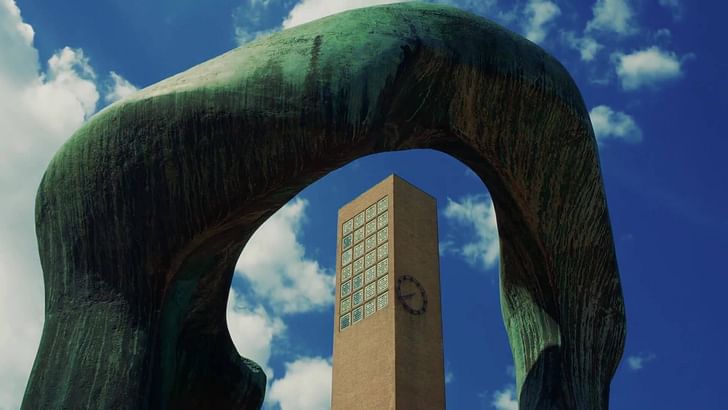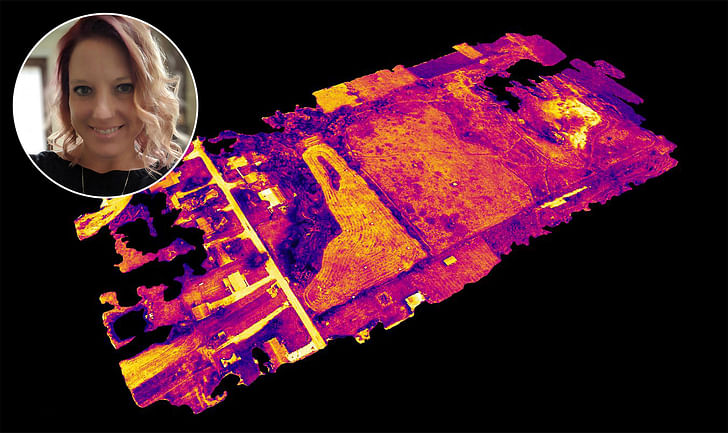

On March 19th and 26th, Exhibit Columbus invites the public to experience its annual exhibition in a new virtual format. A program led by the Landmark Columbus Foundation, this year's theme New Middles: From Main Street To Megalopolis, What Is The Future of The Middle City? allows visitors to "preview design concepts of thirteen site-specific, future-oriented public installations and experience the design process first-hand."
Taking place this Friday, March 19th, and next Friday, March 26th, the exhibition event is broken into four, two-hour sessions. Each featured designer will discuss their work and site installation during virtual sessions across the four themes Ecologies, Geographies, Visibilities, and Possibilities. As the official media sponsors for Exhibit Columbus' Design Presentations, Archinect explores each session to learn more about the designers and their work.
Stay tuned for Part 2 of Archinect's coverage of the event, where we dive into the two remaining sessions taking place on March 26th.
This year's exhibition curators architect Iker Gil and LA-based editor, critic, and curator Mimi Zeiger share, "what makes Columbus' design history so unique is the investment in architecture as a social project." They express their plans to help the Exhibit Columbus team and Columbus community to "shape conversations, installations, and research honoring this past while recognizing the complex social and ecological issues facing American towns and cities at this very moment. [...] it is through architecture and design—through the symposium and exhibition—that we hope to explore meaningful and necessary ways forward."
For Friday, March 19th's sessions: Ecologies and Geographies, Archinect learns more about each designer and their installation site.
Kicking off the first of 4 sessions, Ecologies explores the networks and shared environments that bind us together across species and landscapes. Joining the event and providing feedback will be five special guests such as David Brown (2021 Artistic Director, Chicago Architecture Biennial) and Mark Jones (Director of Columbus Parks Department).
Featured Designer: Hoeferlin is the principal of Derek Hoeferlin Design [dhd] and Associate Professor and Chair of the Landscape Architecture and Urban Design programs at the Sam Fox School of Design & Visual Arts at Washington University in St. Louis. His research focuses on integrated water-based design strategies throughout the Mississippi, Mekong, and Rhine river basins. His design-research project "prioritizes a double-meaning of WATERSHEDS as a transformative agent for the design disciplines, and at multiple scales -- defines as 'Way Beyond Bigness: The Need for a Watershed Architecture.'" Hoeferlin is also a University Design Research Fellow.
Site Details: The first site is The Upland Columbus Pump House, which was built in 1903 and designed by Harrison Albright. Overlooking the East Fork of the White River, this site has a strong connection to the riverfront and the history of Columbus.
Featured Designers: Recipients of the J. Irwin and Xenia S. Miller Prize, the Minneapolis-based creative practice Dream the Combine is led by Jennifer Newsome and Tom Carruthers. In 2018, Archinect spoke with Newsom and Carruthers after they were recognized as winners of MoMA PS1's 2018 Young Architects Program. Their creative practice focuses on site-specific installations that explore "metaphor, imaginary environments, and perceptual uncertainties that cast doubt on our known understanding of the world."
Site Details: In 1993, landscape architect Michael Van Valkenburgh completed the redesign of Mill Race Park that honored the site’s heritage and ecology while looking to the future. Stanley Saitowitz designed the architectural elements, including an Observation Tower offering a view of Columbus’ downtown architecture. This year, the duo will be featured at Mill Race Park alongside Joyce Hwang.
Featured Designer: University Design Research Fellow Hwang is a distinguished academic and practicing professional. She is the Associate Professor and Associate Chair of Architecture at the University at Buffalo, the State University of New York as well as the founder of the architectural and research practice Ants of the Prairie.
Site Details: In 1993, landscape architect Michael Van Valkenburgh completed the redesign of Mill Race Park that honored the site’s heritage and ecology while looking to the future. Stanley Saitowitz designed the architectural elements, including an Observation Tower offering a view of Columbus’ downtown architecture. Hwang will be featured at Mill Race Park alongside Dream the Combine.
The next session taking place on March 19th is Geographies. During this session, presenters will discuss new mapping technologies and advanced ways of making. Joining the event and providing feedback will be five special guests including Sean Anderson (Associate Curator, Department of Architecture and Design, The Museum of Modern Art) and Irene Sunwoo (John H. Bryan Chair of Architecture and Design, Art Institute of Chicago).

Featured Designer: University Design Research Fellow, Kim is also Assistant Professor at the J. Irwin Miller Architecture Program of Indiana University. Kim leads haptiK|B, Kim Bybee Design alongside Dorian Bybee. The practice's research focuses on "architectural and industrial design projects using local materials such as Indiana Limestone and utilizes a spectrum of conventional and high-tech mediums, such as digital modeling, parametric programming, and many different types of digital fabrication."
Site Details: Completed in 1942, Finnish architect Eliel Saarinen's First Christian Church is known as one of the first modern religious buildings in the United States. Interior elements were designed by Charles Eames, Saarinen’s wife Loja, and son Eero.

Featured Designer: Assistant Professor of Landscape Architecture at Ball State University, Yates' research focuses on "dynamic landscape illustration and simulation, using sensing methods in the design process, including Geographic Information Systems, and UAVs (drones) in responsive design, and post-industrial urban landscapes."
Site Details: A residential block since 1870, the three buildings and courtyard are now known as Franklin Square was renovated by Xenia S. Miller in 1964 and later donated to Heritage Fund - The Community Foundation of Bartholomew County.
Featured Designer: Kripa and Mueller are the founding partners of the collaborative interdisciplinary practice, AGENCY. Their work focuses on "engaging contemporary culture through architecture, urbanism, and advocacy." Krip is the assistant Professor and Acting Director at Texas Tech College of Architecture (CoA) – El Paso and Director of Projects at POST (Project for Operative Spatial Technologies). Mueller is a Research Assistant Professor at Texas Tech University College of Architecture (CoA) and Director of Research at POST (Project for Operative Spatial Technologies.
Site Details: When John Crump opened the theater as Crump’s New Theatre in 1889, it was the first stand-alone opera house in Columbus. The Art Deco façade was designed by architect Alden Merenda in 1941 and the interior features various campaigns of additions and renovations. Despite numerous plans to restore the building, in April of 2019 the Crump was placed on Indiana Landmarks' "Top 10 Most Endangered List." Kripa and Mueller's installation will utilize the theatre's site.
--
*Acknowledging the land the exhibition is held on and the city's name Exhibit Columbus and Landmark Columbus Foundation shares, " Landmark Columbus Foundation acknowledges that this area has been a site of human activity for more than 12,000 years through the rich and vibrant cultures of the Adena, Hopewell, Cahokia, Shawnee, Miami, and Kickapoo, and Delaware Nations. In a state named for Indians, in a city named for Christopher Columbus, we recognize that many people called this region home centuries before the first Europeans arrived.
Although this land was ceded to the United States of America by the Miami and Delaware Nations through the Treaty of St. Mary’s in 1818, we recognize that the languages, culture, and traditions of these nations continue to this day. At the natural confluence of waterways and rich soil, the Columbus area has long drawn people to gather. As we continue to make Columbus the best city of its size, we strive to be good stewards of this land and place, as those before us.
Katherine is an LA-based writer and editor. She was Archinect's former Editorial Manager and Advertising Manager from 2018 – January 2024. During her time at Archinect, she's conducted and written 100+ interviews and specialty features with architects, designers, academics, and industry ...
1 Comment
The presentations so far this morning have been SO GOOD!
Block this user
Are you sure you want to block this user and hide all related comments throughout the site?
Archinect
This is your first comment on Archinect. Your comment will be visible once approved.